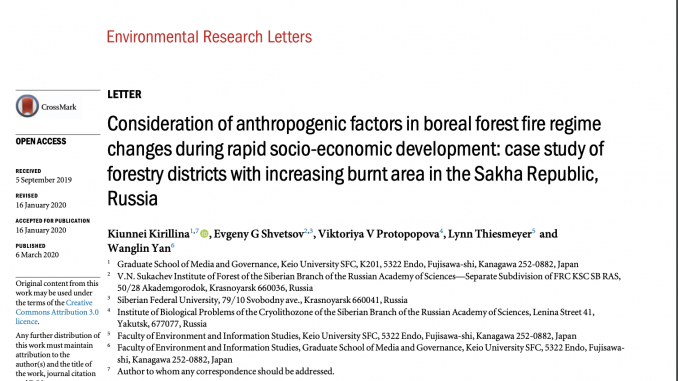
Kiunnei Kirillina
Forest fire is a complex natural phenomenon affecting and being affected by biogeochemical cycles, global climate and human society. Contemporary fire regimes are becoming susceptible to complex interactions among climate change, land use, and direct human influences such as industrial activities in forests. Therefore, it is critically important to understand the characteristics of these changing fire regimes in order to mitigate today wildfire problem, especially in the sensitive ecosystems such as Boreal forests. This study aims to develop a systems analytic approach for identifying characteristics of contemporary fire regimes for the region recently affected by warming and rapid industrialization to determine how these trends were related with fire activity on the example of the most fire-hazardous region of Boreal Russia, the Sakha Republic for 1996-2018. The research was conducted in three steps. The first step was to characterize the fire regimes and their spatiotemporal shifts with original set of fire parameters, and historical trends, evolutionary patterns, fire seasonality and causes. The novel method based on the regime shift analysis identified the specific inflection points in the evolution of fire regimes such as transitions to a new, more severe fire regimes illustrated by the increased burned area. The relationship between anthropogenic activity and forest fires was examined in GIS-environment. Significant increases of the burned area were found in the forestry districts affected by recent industrialization. The region also evidenced the extension of fire season. The second step was to find the connections between the identified changes in fire regimes and regional climate change. Based on meteorological observations, the research used the magnitude, pace, inconsistency and significance of climatic changes as signal descriptors of rapid climate changes in fire weather variability, and the related changes in fire regimes by means of descriptive statistics, variability, homogeneity and trend. The results show that significant warming trends in Spring, Autumn and the beginning of Summer extended the duration of fire season and period of peak fires, which resulted in the increases of the burned area. The third step projected the future fire weather based on the datasets of the climate models of CMIP 5 Project during the entire fire season. The results show that current warming and some dryness trends will likely to continue in the future which may enforce regime shift of the forest fires. In conclusions, this study articulated likely shift of the causes in recent Boreal fire regimes, the effects of anthropogenic activity and short-term climate change. The fire regimes were affected by anthropogenic factors shown by significant increases of the ratio of anthropogenic fires and the increase of the burned area in the forestry districts affected by recent industrialization. The timing of significant upward shifts in the evolution of fire regimes matched with periods of climatic warming, which accompanied the industrial development projects in the same forestry districts. The findings request updated forest management and fire suppression strategies. Further, this research intends to provide the scientific evidence on new interrelationships between climate change, anthropogenic activities and forest fires as a complex system, which has a potential to affect the global climate.
Citation:
Consideration of anthropogenic factors in boreal forest fire regime changes during rapid socio-economic development: case study of forestry districts with increasing burnt area in the Sakha Republic, Russia
Kiunnei Kirillina7,1, Evgeny G Shvetsov2,3, Viktoriya V Protopopova4, Lynn Thiesmeyer5 and Wanglin Yan6
Published 6 March 2020 • © 2020 The Author(s). Published by IOP Publishing Ltd
, , Focus on Northern Eurasia in the Global Earth and Human Systems: Changes, Interactions, and Sustainable Societal DevelopmentCitation Kiunnei Kirillina et al 2020 Environ. Res. Lett. 15 035009